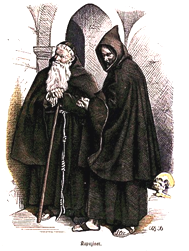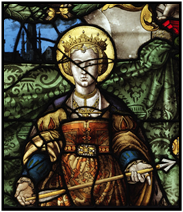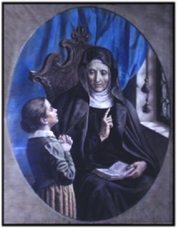


MATTEO DI BASSI FOUNDS THE CAPUCHINS 1528 (H8)
xxxxxThe Italian monk Matteo di Bassi (1495-
Including:
Angela Merici
and
The Order of
Saint Ursula

xxxxxThe Italian monk Matteo di Bassi became a Franciscan friar in 1511 and was ordained a priest about 1520. Anxious that his Order should return to the strict rule of poverty laid down by its founder, St. Francis of Assisi, he travelled barefoot and led an austere, simple life. By 1525 he had attracted many followers by his example and preaching, and in 1528 Pope Clement VII gave his approval to a reform movement. It was first established at Montefalco in Umbria. The rules of the order were drawn up and Matteo was elected the first vicar general of the Capuchins, so called because of the particular pointed hood worn by its friars, known as a capuche. Within fifty years the order numbered 17,000 and it reached its maximum of 34,000 in the middle of the eighteenth century. In its early years the movement was employed in support of the counter-
di Bassi became a Franciscan friar in 1511 and was ordained a priest about 1520. Anxious that his Order should return to the strict rule of poverty laid down by its founder, St. Francis of Assisi, he travelled barefoot and led an austere, simple life. By 1525 he had attracted many followers by his example and preaching, and in 1528 Pope Clement VII gave his approval to a reform movement. It was first established at Montefalco in Umbria. The rules of the order were drawn up and Matteo was elected the first vicar general of the Capuchins, so called because of the particular pointed hood worn by its friars, known as a capuche. Within fifty years the order numbered 17,000 and it reached its maximum of 34,000 in the middle of the eighteenth century. In its early years the movement was employed in support of the counter-
xxxxxSome ten years after the formation of the Capuchins, Angela Merici (c1470-
xxxxxSome ten years after the formation of the Capuchins, a Roman Catholic order was founded in Brescia, Italy, by Angela Merici (c1470-
of the Capuchins, a Roman Catholic order was founded in Brescia, Italy, by Angela Merici (c1470-
xxxxxAngela Merici was born in Desenzano  in the Republic of Venice in about 1472. After joining the Third Order of St. Francis, she returned to her home town in about 1492 and organised a group of young women to teach the catechism to the children of the village. In 1506, whilst at prayer, she had a vision and from then on dedicated herself to the founding of a society of virgins at Brescia. The aim of the society was to restore or strengthen family life by teaching young girls the Christian faith. She drew up the rules of the movement in 1536 and was elected the order’s superior the following year. She died in 1540 and was canonised (made a saint) in May 1807.
in the Republic of Venice in about 1472. After joining the Third Order of St. Francis, she returned to her home town in about 1492 and organised a group of young women to teach the catechism to the children of the village. In 1506, whilst at prayer, she had a vision and from then on dedicated herself to the founding of a society of virgins at Brescia. The aim of the society was to restore or strengthen family life by teaching young girls the Christian faith. She drew up the rules of the movement in 1536 and was elected the order’s superior the following year. She died in 1540 and was canonised (made a saint) in May 1807.



Acknowledgements
St. Ursula: detail, stained-
H8-